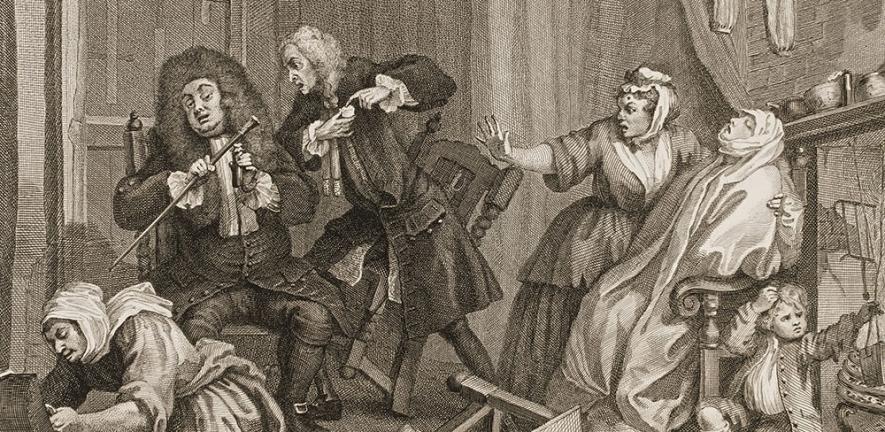
The unlikely coincidence of a local hospital record and a census led by a pioneering physician has enabled the first study charting rates of venereal disease in 18th century England, revealing high infection levels in the city of Chester at this time.
The unlikely coincidence of a local hospital record and a census led by a pioneering physician has enabled the first study charting rates of venereal disease in 18th century England, revealing high infection levels in the city of Chester at this time.
"Because we haven’t been able to study the impact of STIs, much of the history of British population change has been written as if there wasn’t any.”
Simon Szreter
A new study has, for the first time, provided statistical information about the likely rate of venereal disease in a community in 18th century urban England. These rare findings are limited to a single city, but if they are representative of other urban centres, they suggest that the rate of sexually-transmitted infection was both surprisingly high, approximately equal among the two sexes and significantly greater than in rural areas.
Very unusually for a pre-census period, the research succeeded in measuring levels of venereal disease in the city of Chester, as well as its immediate surroundings, during the 1770s. It was carried out by Simon Szreter, Professor of History and Public Policy at St John’s College, University of Cambridge, who used two unique and contemporaneous sources to construct a picture of the rate at which people were contracting syphilis, then known as “the pox”.
He found that STI rates in Chester were surprisingly high. The study estimates that in the mid-1770s, approximately 8% of residents of both sexes had been infected with syphilis before the age of 35. The estimated infection rate among under-35s in rural communities within a 10 mile radius of the city, however, was a little under 1%.
Such figures contrast with the much lower infection rates of modern times. A recently published report by Public Health England, for example, shows that there were 5,920 diagnoses of syphilis across England as a whole during 2016. Even this is abnormally high; it represents the highest level since 1949 and has led to warnings about cuts to sexual health services.
The prevalence of sexually-transmitted diseases during the pre-modern era influenced both fertility and mortality rates, and being able to determine the rate of infection potentially allows historians to make better judgements about population change. But sources containing statistical information about STIs before the start of the 20th century are virtually non-existent, and the rate has therefore typically been regarded as incalculable.
Szreter’s study was made possible by the extraordinary coincidence of two unique pieces of evidence – the Chester Infirmary’s admissions register, or “Journal of Patients”, which survives for the years 1773-5, and a census carried out by an eminent local physician, John Haygarth, in 1774.
Although a national census only began in 1801, Haygarth – who in a further coincidence had studied at St John’s College, where Szreter is now a Fellow – was an unusually enlightened practitioner who developed his own census for Chester to calculate the prevalence of different types of disease.
“When I heard about the infirmary records, I thought, bingo!” Szreter said. “We have just enough information from Haygarth to reconstruct the most probable age structure of the City of Chester in 1774 – the middle of the three years for which we also have detailed information about who was entering the infirmary and why.”
“Not many academics have the chance to collaborate in their research environment with an eminent member of their own College who died over 200 years ago. But this brand new research would have been impossible without Haygarth’s highly original older research from the 1770s.”
The Chester Infirmary recorded 177 cases of “venereal distemper” during the 3 years 1773-5. These would have been treated depending on whether the condition was mild, and therefore likely to have been gonorrhoea (“the clap”), or more serious, and therefore syphilis (“the pox”).
The gruelling but almost universally-accepted treatment for syphilis involved the continual, supervised application of mercury, which caused patients to produce pints of saliva, supposedly flushing out the venereal poisons. Side-effects included swollen gums, mouth ulcers, and severe halitosis. Typically, the process took at least 35 days.
Because of this, Szreter was able to identify likely syphilitic cases at the infirmary depending on the length of stay among patients reporting a venereal “distemper”. He then compared the figure with a set of age-specific estimates about the size of the at-risk population based on Haygarth’s census. Finally, he was able to make a comparable estimate for the rural population within a 10-mile radius of Chester itself.
Together, the results show that almost exactly 8% of residents in Chester had been infected with what was probably syphilis before they were 35, and that the urban population was approximately 8.65 times more likely to contract the disease compared with people living in the surrounding 290 square miles of countryside.
“It is the first time that we have had any historical statistical evidence like this for sexual disease rates anywhere in Britain,” Szreter said. “The demographic story of this period is defined by mortality and fertility, and rates of venereal disease could of course affect both. But because we haven’t been able to study the impact of STIs, much of the history of British population change has been written as if there wasn’t any.”
Aside from his pioneering census work, John Haygarth is known to have kept detailed patient records, which could provide further, valuable information about medicine and disease at this time. So far, these documents have never been found.
Szreter hopes that they may one day turn up, although his own search – including in the St John’s College archives – has proven fruitless to date. “It’s possible that they were thrown away some time after Haygarth’s death,” he added. “If they were ever discovered, it would be the medical historian’s equivalent of finding Richard III in a car park.”
The study, Treatment Rates for the Pox in early modern England, is published in the academic journal, Continuity and Change.

The text in this work is licensed under a Creative Commons Attribution 4.0 International License. For image use please see separate credits above.




